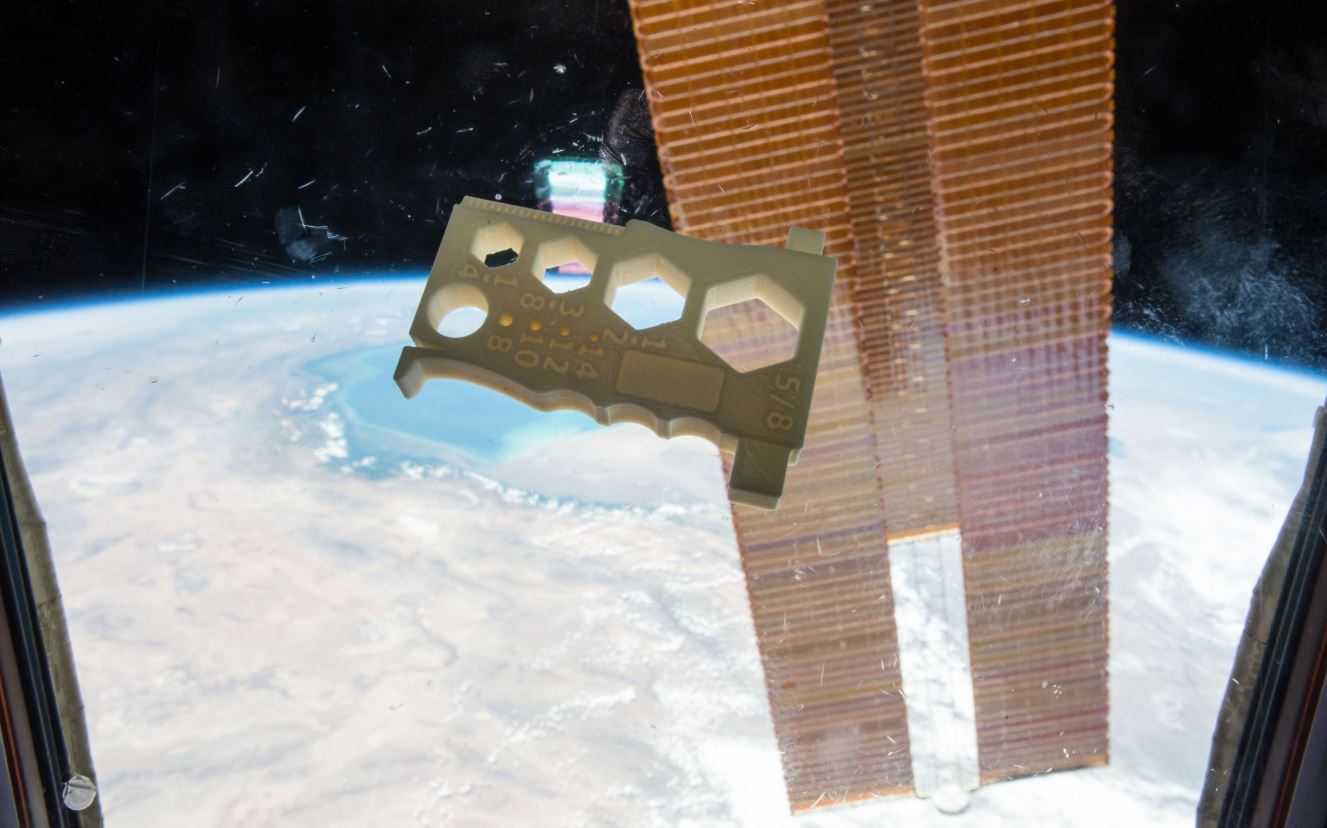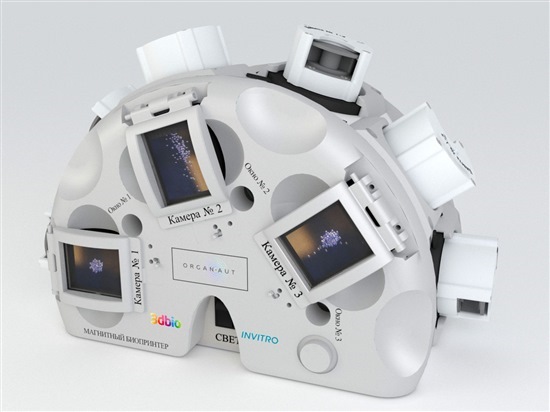

News
First living tissue 3D printed in space aboard International Space Station
Using the “Organaut”, a 3D bioprinter designed for microgravity, Russia has become the first country to print living tissue in space. After a December 3rd cargo delivery to the International Space Station (ISS), cosmonaut Oleg Kononenko completed an experiment with the machine in the Russian sector of the station, successfully producing human cartilage tissue and a rodent thyroid gland. The Organaut was designed via a collaboration with the printer’s maker, 3D Bioprinting Solutions, and Russia’s national space agency, Roscosmos. The United States also has its own bioprinting mission scheduled for the first half of 2019, joining in the march to develop biological solutions for problems that space is well suited to solve.
A 3D bioprinter operates by creating one layer at a time of specified tissue or stem cell material arranged as needed to grow and form as biologically programmed to do. As summarized by Aryeh Batt, the CEO of Precise Bio, a company dedicated to 3D printed bioproducts for human eyes, “Essentially, the biology does the work, but you have to put them in the correct environment to make it happen.” In the case of Organaut, an internal robotic mechanism drips living cell fabric layers from an automatic syringe. When living tissue is bioprinted under Earth’s gravity, the artificial cells grow in a flatter structure than their natural state in the human body. In microgravity, however, they form a shape closer to their normal dimensions.
Along with demonstrating the growth advantages of microgravity, Organaut’s tissue samples will provide the ability to study the effect of radiation on the body. “We will look at how the constructs came together, and how they behaved,” confirmed Usef Hesuani, head of laboratory projects and a managing partner of 3D Bioprinting Solutions in a recent press conference. The original Organaut printer was aboard the Soyuz MS-10 spacecraft which experienced an launch failure on October 11, 2018, forcing the U.S. and Russian crew to make an emergency landing. A second one was quickly put together for the subsequent mission.

The parent company of 3D Bioprinting Solutions is INVITRO, the largest private medical company in Russia. Founded in 1995 by Aleksandr Ostrovsky, it has 8 laboratories and over 1000 medical offices in eastern Europe, but is primarily based in Skolkovo, a high technology business area in Moscow. Bioprinting Solutions made headlines in 2015 when it printed and transplanted a functioning mouse thyroid gland. The experiment performed aboard the ISS with Organaut was a modified version of their prior work.
Unlike NASA, Roscosmos does not generally partner with private companies for its research endeavors. In an effort to inspire Russian students to enter STEM fields within their country, the agency sought to spotlight the developing bioprinting industry by using the Organaut. The successful partnership with 3D Bioprinting Solutions has now motivated the agency to continue partnering with private companies in the future. The company itself also sees advantages to collaborations of its own with other Skolkova-area manufacturers. “We have companies that are making satellite platforms…it is possible to conduct a similar experiment amid microgravity on small spacecraft [like satellites]…smaller and cheaper,” noted Ivan Kosenkov, 3D Bioprinting Solutions’ project manager.
Organaut’s printed tissues were returned to Earth with the Soyuz MS-09 spacecraft on December 20th, and the results of the experiment are expected to be published at the end of January 2019. In February, NASA plans to send a bioprinter capable of producing beating heart tissue to the ISS. Named the 3D BioFabrication Facility (BFF), the machine was developed through a partnership with two companies well-established in 3D printing and on-orbit hardware, nScrypt and Techshot. Since the thickness of heart tissue is difficult to build under gravity without structural assistance that could impede functionality, the companies developed the BFF with the hypothesis that microgravity would overcome this limitation. Thus far, the concept has been proven during parabolic flight tests, i.e., aboard the “Vomit Comet” airplane that performs multiple parabolic maneuvers in an airliner to create 20-30 seconds of weightlessness each.

Elon Musk
Elon Musk’s X will start using a Tesla-like software update strategy
The initiative seems designed to accelerate updates to the social media platform, while maintaining maximum transparency.

Elon Musk’s social media platform X will adopt a Tesla-esque approach to software updates for its algorithm.
The initiative seems designed to accelerate updates to the social media platform, while maintaining maximum transparency.
X’s updates to its updates
As per Musk in a post on X, the social media company will be making a new algorithm to determine what organic and advertising posts are recommended to users. These updates would then be repeated every four weeks.
“We will make the new 𝕏 algorithm, including all code used to determine what organic and advertising posts are recommended to users, open source in 7 days. This will be repeated every 4 weeks, with comprehensive developer notes, to help you understand what changed,” Musk wrote in his post.
The initiative somewhat mirrors Tesla’s over-the-air update model, where vehicle software is regularly refined and pushed to users with detailed release notes. This should allow users to better understand the details of X’s every update and foster a healthy feedback loop for the social media platform.
xAI and X
X, formerly Twitter, has been acquired by Elon Musk’s artificial intelligence startup, xAI last year. Since then, xAI has seen a rapid rise in valuation. Following the company’s the company’s upsized $20 billion Series E funding round, estimates now suggest that xAI is worth tens about $230 to $235 billion. That’s several times larger than Tesla when Elon Musk received his controversial 2018 CEO Performance Award.
As per xAI, the Series E funding round attracted a diverse group of investors, including Valor Equity Partners, Stepstone Group, Fidelity Management & Research Company, Qatar Investment Authority, MGX, and Baron Capital Group, among others. Strategic partners NVIDIA and Cisco Investments also continued support for building the world’s largest GPU clusters.
News
Tesla FSD Supervised wins MotorTrend’s Best Driver Assistance Award
The decision marks a notable reversal for the publication from prior years, with judges citing major real-world improvements that pushed Tesla’s latest FSD software ahead of every competing ADAS system.

Tesla’s Full Self-Driving (Supervised) system has been named the best driver-assistance technology on the market, earning top honors at the 2026 MotorTrend Best Tech Awards.
The decision marks a notable reversal for the publication from prior years, with judges citing major real-world improvements that pushed Tesla’s latest FSD software ahead of every competing ADAS system. And it wasn’t even close.
MotorTrend reverses course
MotorTrend awarded Tesla FSD (Supervised) its 2026 Best Tech Driver Assistance title after extensive testing of the latest v14 software. The publication acknowledged that it had previously criticized earlier versions of FSD for erratic behavior and near-miss incidents, ultimately favoring rivals such as GM’s Super Cruise in earlier evaluations.
According to MotorTrend, the newest iteration of FSD resolved many of those shortcomings. Testers said v14 showed far smoother behavior in complex urban scenarios, including unprotected left turns, traffic circles, emergency vehicles, and dense city streets. While the system still requires constant driver supervision, judges concluded that no other advanced driver-assistance system currently matches its breadth of capability.
Unlike rival systems that rely on combinations of cameras, radar, lidar, and mapped highways, Tesla’s FSD operates using a camera-only approach and is capable of driving on city streets, rural roads, and freeways. MotorTrend stated that pure utility, the ability to handle nearly all road types, ultimately separated FSD from competitors like Ford BlueCruise, GM Super Cruise, and BMW’s Highway Assistant.
High cost and high capability
MotorTrend also addressed FSD’s pricing, which remains significantly higher than rival systems. Tesla currently charges $8,000 for a one-time purchase or $99 per month for a subscription, compared with far lower upfront and subscription costs from other automakers. The publication noted that the premium is justified given FSD’s unmatched scope and continuous software evolution.
Safety remained a central focus of the evaluation. While testers reported collision-free operation over thousands of miles, they noted ongoing concerns around FSD’s configurable driving modes, including options that allow aggressive driving and speeds beyond posted limits. MotorTrend emphasized that, like all Level 2 systems, FSD still depends on a fully attentive human driver at all times.
Despite those caveats, the publication concluded that Tesla’s rapid software progress fundamentally reshaped the competitive landscape. For drivers seeking the most capable hands-on driver-assistance system available today, MotorTrend concluded Tesla FSD (Supervised) now stands alone at the top.
News
Elon Musk’s Grokipedia surges to 5.6M articles, almost 79% of English Wikipedia
The explosive growth marks a major milestone for the AI-powered online encyclopedia, which was launched by Elon Musk’s xAI just months ago.

Elon Musk’s Grokipedia has grown to an impressive 5,615,201 articles as of today, closing in on 79% of the English Wikipedia’s current total of 7,119,376 articles.
The explosive growth marks a major milestone for the AI-powered online encyclopedia, which was launched by Elon Musk’s xAI just months ago. Needless to say, it would only be a matter of time before Grokipedia exceeds English Wikipedia in sheer volume.
Grokipedia’s rapid growth
xAI’s vision for Grokipedia emphasizes neutrality, while Grok’s reasoning capabilities allow for fast drafting and fact-checking. When Elon Musk announced the initiative in late September 2025, he noted that Grokipedia would be an improvement to Wikipedia because it would be designed to avoid bias.
At the time, Musk noted that Grokipedia “is a necessary step towards the xAI goal of understanding the Universe.”
Grokipedia was launched in late October, and while xAI was careful to list it only as Version 0.1 at the time, the online encyclopedia immediately earned praise. Wikipedia co-founder Larry Sanger highlighted the project’s innovative approach, noting how it leverages AI to fill knowledge gaps and enable rapid updates. Netizens also observed how Grokipedia tends to present articles in a more objective manner compared to Wikipedia, which is edited by humans.
Elon Musk’s ambitious plans
With 5,615,201 total articles, Grokipedia has now grown to almost 79% of English Wikipedia’s article base. This is incredibly quick, though Grokipedia remains text-only for now. xAI, for its part, has now updated the online encyclopedia’s iteration to v0.2.
Elon Musk has shared bold ideas for Grokipedia, including sending a record of the entire knowledge base to space as part of xAI’s mission to preserve and expand human understanding. At some point, Musk stated that Grokipedia will be renamed to Encyclopedia Galactica, and it will be sent to the cosmos.
“When Grokipedia is good enough (long way to go), we will change the name to Encyclopedia Galactica. It will be an open source distillation of all knowledge, including audio, images and video. Join xAI to help build the sci-fi version of the Library of Alexandria!” Musk wrote, adding in a later post that “Copies will be etched in stone and sent to the Moon, Mars and beyond. This time, it will not be lost.”








